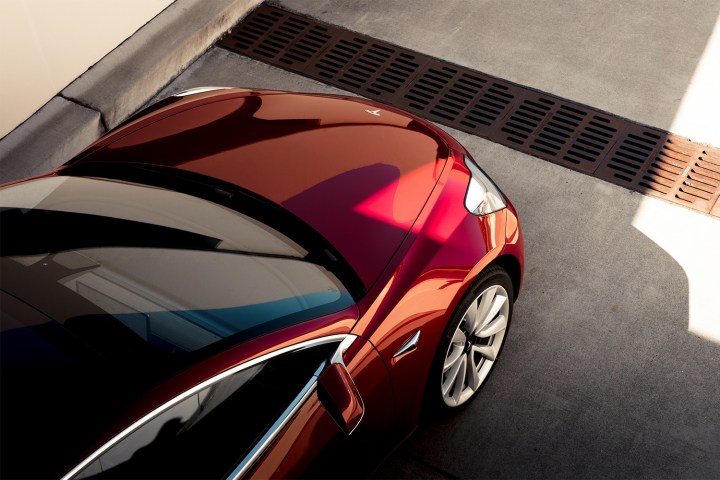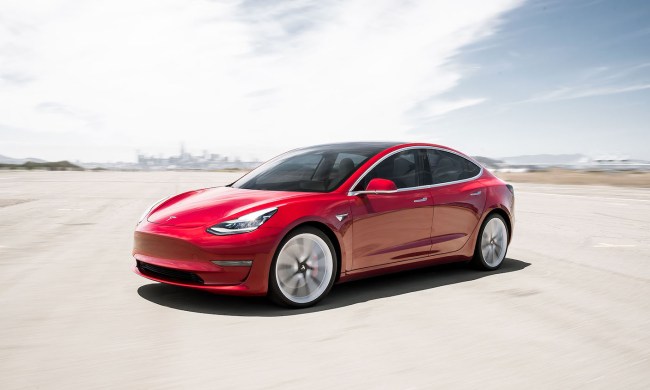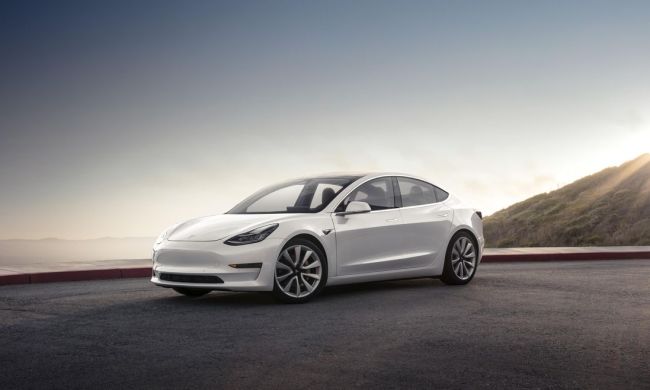
To briefly sum up the specifications sheet, the most basic version of the car (which corresponds to a base price of $35,000) ships with a 220-mile range. It accelerates to 60 mph from a standstill in 5.6 seconds, and it goes on to a top speed of 130 mph. Tesla’s Supercharger station replenishes about 130 miles of range every 30 minutes, though Model 3 owners need to pay every time they plug into the network.
Tesla has refrained from publishing other important details such as the size of the battery pack, as well as the motor’s torque and horsepower outputs. The company prefers “focusing on range rather than capacity,” a spokesperson told CNET’s Roadshow.
Although scant, the performance and range statistics published by Tesla are impressive.
Buyers who need to drive further can step up to the Long Range Battery, which is a $9,000 option. For $44,000, you get up to 310 miles of range, 170 miles of driving per 30 minutes of charging, a 140-mph top speed, and a 5.1-second sprint to 60 mph. Again, facts such as the battery pack’s size and the motor’s output are being kept secret for the time being.
Every Model 3 regardless of battery size comes standard with automatic emergency braking and collision avoidance. Priced at $5,000, Tesla’s Autopilot software keeps the 3 in its lane, automatically changes lanes, navigates freeway on- and off-ramps, and even parks the car on its own.
Although relatively scant, the statistics published by Tesla are impressive. Now let’s see how the Model 3 compares to its main rivals.
Chevrolet Bolt
The Tesla Model 3’s most direct competitor is the Chevrolet Bolt. It’s not as sleek-looking or as luxurious as the newest Tesla on the block, but it’s available right now from Chevrolet dealers nationwide — no reservation required, and no waiting. Pricing starts at $37,495 before incentives are factored in, which places it in the same price bracket as the 3.
For the money, you get a 60-kWh battery pack that provides up to 238 miles of range, according to the Environmental Protection Agency. The Bolt’s electric motor zaps the front wheels with 200 horsepower and 266 pound-feet of torque. It’s more of a zippy hatchback than a performance sedan, but it still performs the benchmark zero-to-60-mph sprint in a respectable 6.5 seconds.
The Bolt offers more standard paint colors than the Model 3. Electronic driving aids such as lane-keeping assist with lane departure warning and automatic braking are bundled into a $495 option package that is only offered on the $41,780 Premier trim. DC fast charging (which gives the Bolt about 90 miles of range in just 30 minutes) is another option, at a cost of $750. We’ll have to wait and see if the Model 3 gives this 2017 Car Awards winner a run for its money.
So attractive is the Bolt EV, that Car and Driver reports it is on pace to outsell every other electric car — except for the significantly more expensive Tesla Model S. GM says 11,670 Bolt EVs have been sold in 2017 alone, a figure made more impressive by the fact that Bolt EVs are only sold at 40 percent of all Chevy dealers. This EV is hot, hot, hot!
BMW 3 Series
The Model 3 is electric first and foremost, but it’s also a compact sports sedan. In that respect, it needs to fend off competition from the BMW 3 Series, which has long been considered the gold standard in the sport sedan segment. Now in its sixth generation, and less enthusiast-oriented than before, the 3 is available in six different variants.
If electrification is a must, the 330e iPerformance fits the bill.
If electrification is a must, the 330e iPerformance fits the bill. Its drivetrain consists of a turbocharged 2.0-liter four-cylinder engine, a compact electric motor, and a 7.6-kWh lithium-ion battery pack. It sends 248 horsepower and 310 pound-feet of torque to the rear wheels via an eight-speed automatic transmission.
That’s enough grunt for a zero-to-60 time of 5.9 seconds. All juiced up, the 330e has a total driving range of 350 miles, including 17 miles on electricity alone.
Pricing starts at $44,100. Like Tesla, BMW charges extra for metallic paint. Other options include a rearview camera, which comes standard on the Model 3. BMW bundles navigation into a $2,750 technology package that also includes a head-up display (a feature not available on the Model 3), real-time traffic information, and BMW Connected compatibility.
The rest
The Model 3 faces competition from members of Tesla’s own stable. You can pick up a lightly used Model S right away for about $45,000. The S is much more spacious than its smaller sibling, but the cars in Tesla’s used inventory are relatively basic, rear-wheel drive variants that offer a little less range than the range-topping 3.
The Model S 60 drives for 210 miles on a charge. Both the 85 and the performance-oriented P85 variants are certified for 265 miles. All three come with free supercharging, so the reduced range might be an acceptable trade-off depending on where you live.

Buyers in the market for a premium electric car can also look at the futuristic-looking BMW i3. Priced at $42,400 before incentives, the i3 offers a roomy cabin built with high-quality materials, user-friendly tech features, a 50:50 weight distribution, and a state-of-the-art carbon fiber structure. Unfortunately, the downside to BMW’s first full-production battery-powered model is that it only drives for 114 miles before the battery pack needs a charge — hello, range anxiety! Better executed, the i3 could have squashed the Model 3 like a fruitfly before it even hit the market.
The other electric cars on sale today don’t come anywhere near the Model 3 in terms of range, features, or both. These include the Nissan Leaf, the Ford Focus Electric, the Volkswagen e-Golf, and the Hyundai Ioniq Electric. However, the segment is going to more crowded than the Atlanta airport in just a few short years.
The future
Volkswagen, Mercedes-Benz, Jaguar, Volvo and BMW are among the numerous so-called legacy automakers pouring millions of dollars into their research and development programs to trounce Tesla at its own game, and end its monopoly on the long-range electric car segment. The first shot will come from Jaguar, which is putting the final touches on the production version of last year’s I-Pace concept. Early reports point to about 300 miles of range, though the i-Pace could end up costing more than the Model 3.
Updated with news of the Bolt EV’s 2017 sales pace.




